Planting to Attract Birds
How to encourage bird populations into your green spaces
Birds are some of our most beloved wildlife. Not only do we enjoy them for their beautiful appearance, their courtship behaviours, their close proximity, and their aerial displays, but also for their mellifluous birdsong, that can bring peace and joy to even the most forlorn individual.
Their value however, goes far beyond the simple pleasures they bring us with their presence. They’re one of nature’s most useful assets for a variety of different jobs, all of which help our green spaces, as well as other wildlife, to thrive.
Firstly, birds are great as a natural pest control against all sorts of insects, which feed on plants and crops. For example, starlings love to feed on larvae that are buried in lawns. They can swoop down and collect invertebrates on the wing, allowing them to feed their chicks an average of 10,000 caterpillars before they leave the nest, according to the RSPB. A greater diversity of birds in the country means a wider range of insects on the menu!

Not only that, but birds are great for encouraging, and actively participating in the growth of plants, bushes, and trees. Birds are some of our best seed dispersers, ingesting the seeds from a wide range of different plant life, before flying off and later depositing the seeds elsewhere via their droppings. We can credit much of our rich, luscious green landscape in the UK to the hard work of our native birds.
Whilst normally thought to be a job left to bees and butterflies, birds can also be useful as pollinators for various types of plants. Birds like hummingbirds, which are native to the Americas, seek out nectar in habitats where insects are not abundant. They play an important role in the pollination of many fruit bearing plants, such as bananas, papaya, nutmeg, and many other staples in our diets which would be lost if it wasn’t for various exotic birds. In the UK, if you’re very lucky, you might catch a glimpse of the rare golden oriole that normally collects nectar in Africa, but can occasionally be seen in the UK throughout May and June.
It’s essential that new development becomes more sensitive to the needs of natural habitats and encourages the cultivation of new environments where birds can thrive. There are many species of birds in the UK that are under threat of extinction due to the disruption of their natural habitats, and this needs to be addressed at the design stage. This is why incorporating biodiversity and tailoring commercial landscaping projects to encourage wildlife is so important, to protect our native species, and to help us to continue to reap the benefits of having a healthy bird population.
How can we encourage birds?
There are many different ways in which we can design our landscape projects in order to encourage birds to our green spaces. Growing trees that offer shelter, and branches for nesting, as well as providing seeds as a food source and material for nest building, is a very effective way of attracting birds to your green space and encouraging populations to flourish. Hedges also help to provide shelter for birds, and act as green corridors for wildlife to be able to move whilst protected. Not only that, flowering plants and trees can provide a wide variety of fruits, berries, nectar, and pollen, which are a valuable food source for birds.
Developers, architects and landscape contractors can add a variety of different plants to their projects in order to encourage biodiversity. Planting a healthy mixture of suitable perennials, shrubs, hedges and trees can provide projects with plenty of different areas of shelter, nesting sites, and food, for a more diverse bird population. Planting native species also helps to encourage biodiversity, as these plants have co-evolved with native wildlife and are adapted to our regional climate and soil variations.
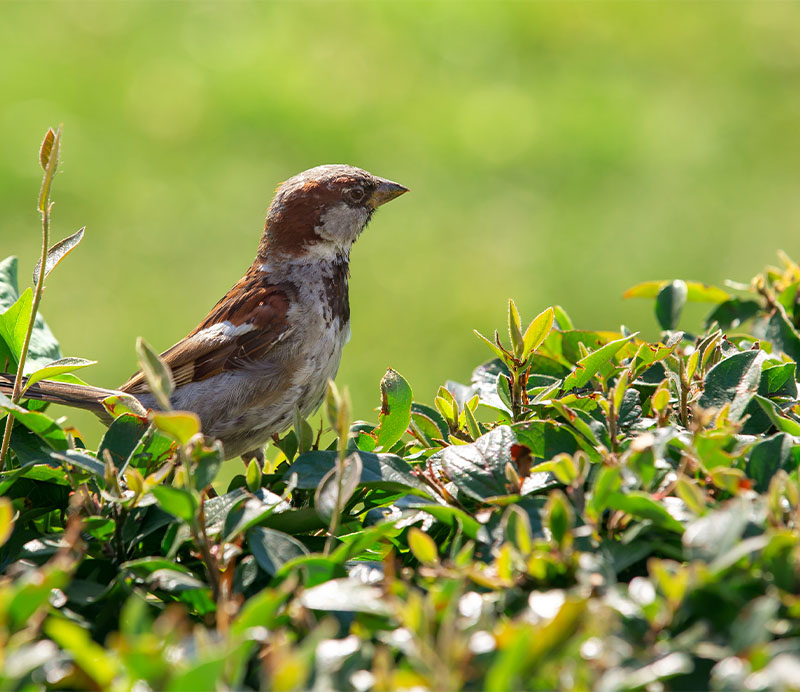
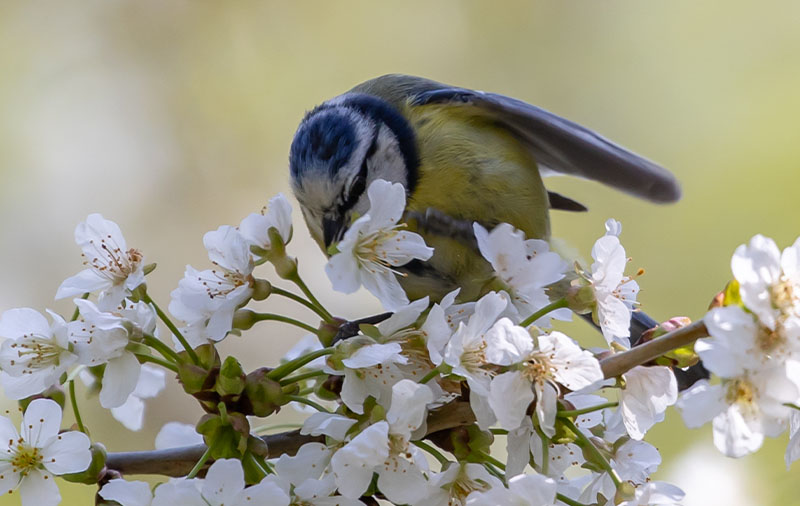
A method that will further boost a project’s popularity with birds is to choose combinations of plants that either flower, or bear fruit and berries at different times of year. Covering as many months and seasons as possible, will ensure there is food to eat throughout the entire calendar year. As food is often scarce coming into the winter months, a great way of keeping birds from travelling elsewhere for food is to ensure to include some plants which flower late in the year. Combining these with spring/summer flowering plants will make sure you have birds in your green space, no matter the season.
Below are some examples of trees, bushes, and hedges, which are particularly bird friendly, and will help encourage their survival and growth in your area.
Trees
Crab apple (Malus sylvestris)
In spring, the crab apple tree attracts various insects. Its blossoms provide valuable early pollen and nectar, especially for bees. The new leaves which emerge serve as nourishment for moth caterpillars, including the eyed hawk-moth, green pug, and pale tussock. Around October, the tree produces small apples about the size of golf balls. Whilst these apples are too sour for most people’s palate, they are a favourite amongst creatures like mice, voles, foxes, badgers, song thrushes, and blackbirds. Even fieldfares and redwings are drawn to the fallen fruits, particularly during harsh winters.
Rowan (Sorbus aucuparia)
Rowan trees bring joy to wildlife in both woodlands and towns. Their slim shape makes them ideal for small gardens. In May, delicate creamy flowers arrive, giving bees and other pollinators pollen and nectar. This helps them during spring, after apple and cherry blossoms have bloomed in April. Caterpillars like the Welsh wave and autumn green carpet types eat the leaves. By summer, red berries develop, becoming a food source for birds like blackbirds, thrushes, redstarts, redwings, and waxwings, which eagerly enjoy this seasonal treat.
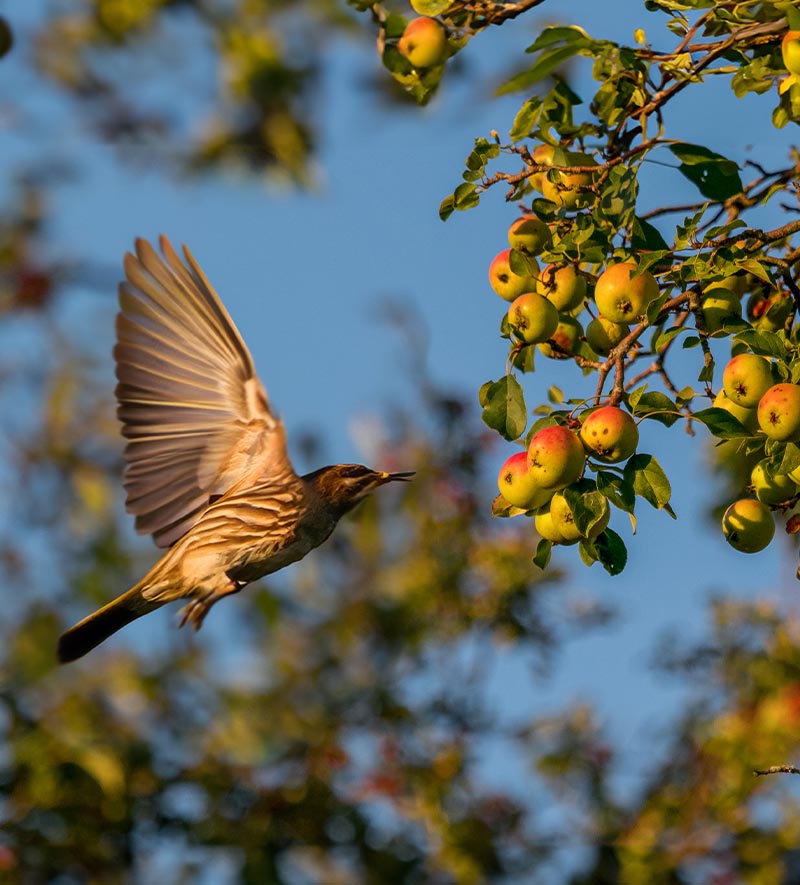
Malus sylvestris
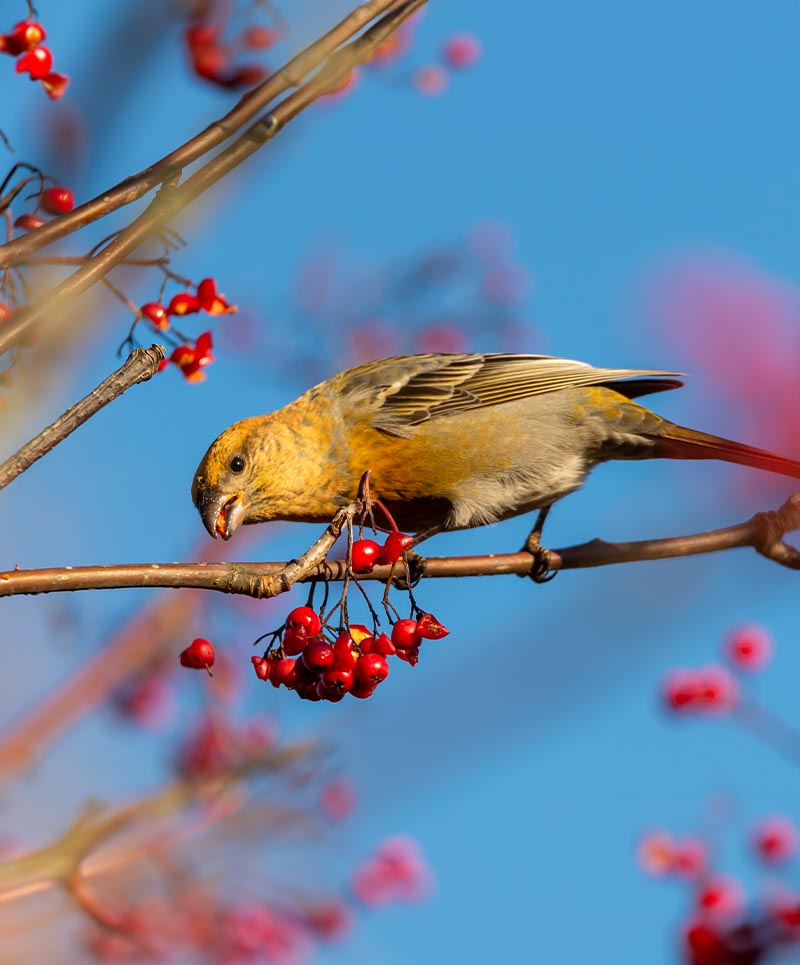
Prunus avium
Silver birch (Betula pendula)
Over 300 kinds of insects rely on silver birch trees for nourishment and protection. Caterpillars of various moths like angle-shades, buff tip, pebble hook-tip, and Kentish glory feed on the leaves. These leaves also attract aphids, which become a food source for ladybirds and other creatures higher up the food chain. This profusion of insect larvae becomes a hearty meal for fledglings during the nesting season. Older tree trunks often serve as nesting sites for woodpeckers and other birds. Meanwhile, small birds such as the long-tailed tit, siskin, greenfinch, and redpoll take pleasure in the plentiful seeds and insects which the tree supports.
Wild cherry (Prunus avium)
Wild cherry earns its name due to its remarkable benefits for wildlife – the “avium” in its scientific name alludes to the birds that consume its fruits. During the peak of summer, ripe cherries are enjoyed by blackbirds, song thrushes, and various other avian species, in addition to badgers, wood mice, and dormice. This tree’s splendid cherry blossoms offer early nectar and pollen to a diverse array of insects in spring. Moreover, its foliage serves as the primary food source for numerous moth caterpillars, including those of the cherry bark, orchard ermine, and short-cloaked moths.
Hedges
Blackthorn (Prunus spinosa)
Blackthorn blooms earlier in the year, providing essential nectar and pollen for bees during spring. Numerous moth caterpillars rely on its leaves as a food source, whilst black and brown hairstreak butterflies choose its branches to lay their eggs. For birds, blackthorn is a valuable asset. Its dense, thorny thickets offer a safe nesting environment, shielding them from predators. Birds also find sustenance in the form of caterpillars and other insects found on its leaves. The addition of juicy black sloes in autumn and winter further aids their survival.
Holly (Ilex aquifolium)
Holly is great for wildlife during the winter months, offering birds a secure nesting and sheltering spot amidst its dense evergreen leaves, providing respite during storms. Beneath the hedge, the deep, dry leaf litter forms a cozy haven for hibernating creatures like toads, hedgehogs, and small mammals. The enduring red berries not only sustain birds but also contribute to the survival of wood mice and dormice during leaner times. In the warmer seasons, the hedge produces small white flowers that yield nectar and pollen, benefiting bees and other pollinators.
Shrubby Honeysuckle (Lonicera nitida)
Lonicera nitida is a perennial shrub similar to honeysuckle, originating from China. Widely favoured as a hedge plant, it stands as a robust and rapidly maturing option for screening, whilst its simplicity in cultivation adds to its allure. Lonicera nitida is a spring flowering plant, and attracts many pollinating insects, with its dense foliage that provides favourable shelter for birds.
Hawthorn (Crataegus monogyna)
Hawthorn is a great choice for native hedging. Its thorny, densely-packed growth not only offers superb nesting spots for birds but also presents blooms that attract pollinators. During autumn, it produces red fruits called haws, cherished by birds and small mammals alike. The foliage, additionally, provides sustenance for moths such as the vapourer (Orgyia antiqua) and light emerald (Campaea margaritata).

Ilex aquifolium ‘Argentea Marginata’
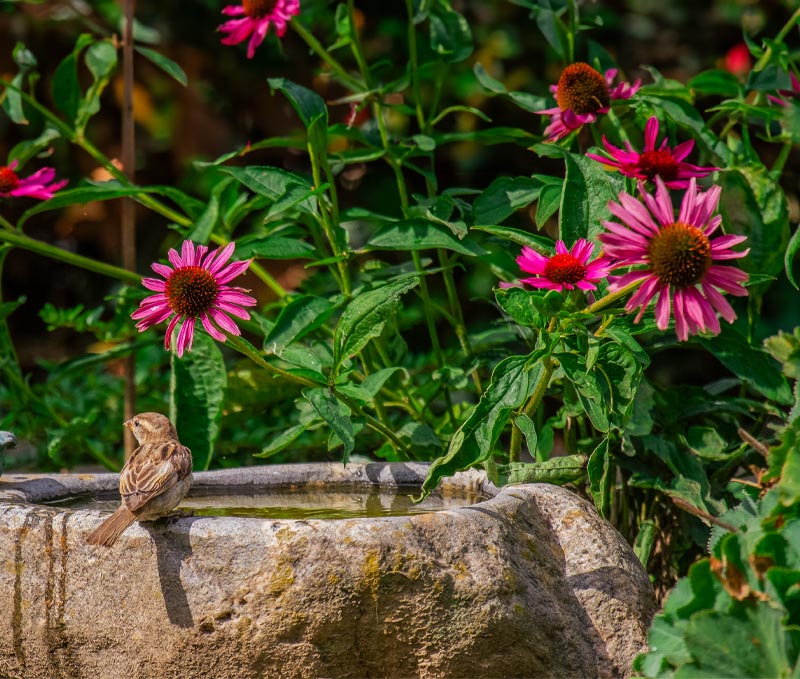
Echinacea purpurea
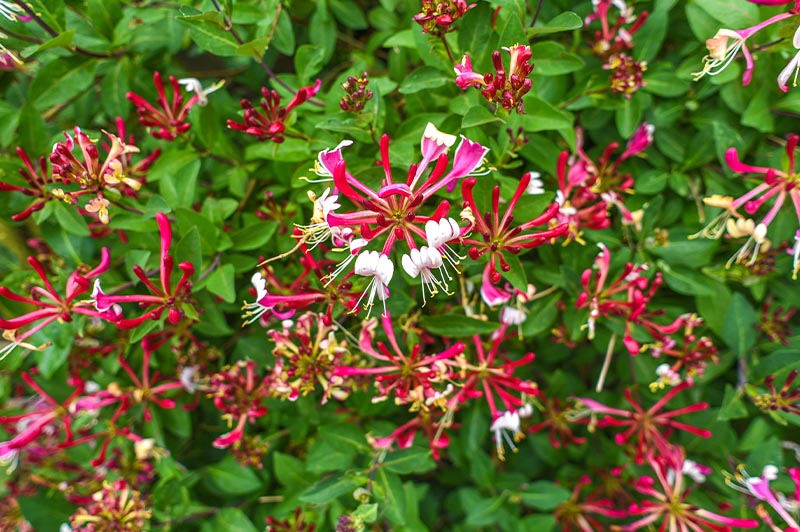
Lonicera periclymenum
Herbaceous
Achillea ‘Coronation Gold’
Achillea ‘Coronation Gold’ boasts elevated growth and abundant golden yellow flowerheads which persist through summer. This particular variety of Achillea is famed for its ability to allure bees, beneficial insects, birds, and diverse pollinators. Its flowers offer a plentiful supply of nectar and pollen, whilst its seeds serve as a source of sustenance for birds.
Purple coneflower (Echinacea purpurea)
Known for their use in herbal medicine, these herbaceous perennials boast charming daisy-like flowers centred around a cone, which lends them their popular name “coneflower.” Echinacea purpurea attracts the likes of bees, birds, and various other pollinators. Its flowers are a treasure trove of nectar and pollen, whilst the seeds they bear offer sustenance to birds. These enduring flowers remain vibrant throughout the summer and display resilience against adverse weather conditions.
Honeysuckle (Lonicera periclymenum)
Honeysuckle, a climber by nature, emerges as the ideal selection for constrained spaces. In the fall, it presents berries and a sanctuary for birds such as thrushes, warblers, and bullfinches. In summer, its scented flowers captivate insects, providing sustenance for diverse avian varieties.
Dog Rose (Rosa canina)
Rosa canina, commonly referred to as dog rose, stands as a robust, arching deciduous shrub. During summer, it showcases delicate pale pink and white blooms, whilst ovoid red fruits emerge in the autumn. This rose variety is famed for its ability to draw in bees, insects, birds, butterflies, moths, and assorted pollinators. It serves as a nourishing plant for caterpillars, boasting flowers rich in nectar and pollen. Additionally, it offers shelter and habitat, drops seeds for birds, and works well planted along a hedge that supports wildlife.
Birds play a vital part in protecting our ecosystems, encouraging biodiversity, and helping to disperse seeds throughout our lovely green landscapes all over the country. Above anything, they’re just nice to have around, whether it’s in your garden, or in a public communal space.
To discuss your planting requirements, please get in touch with the G Team today.

